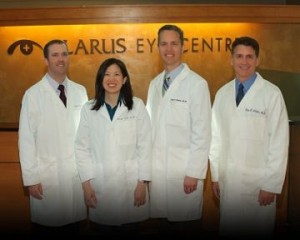Submitted by Dr. Stephen Reck, M.D. Clarus Eye Center

January is Glaucoma Awareness Month, so I wanted to provide a little information on some new developments in glaucoma diagnosis and management at Clarus Eye Centre. Before I do, I should explain what glaucoma is and provide a few helpful links for additional information.
Glaucoma is what we call the group of conditions that cause progressive loss of nerve tissue at the end of the optic nerve, where it enters the back of the eye. Eventually, this nerve damage can result in loss of vision, usually starting in the periphery and advancing toward the center over time. Glaucoma is the leading cause of permanent blindness globally, and it is the second-leading cause of blindness in the United States, behind macular degeneration. Fortunately, most people who have glaucoma never go blind. The key to preventing vision loss from glaucoma is early detection and treatment.
Glaucoma is usually painless and the vision loss usually goes unnoticed until the disease is very advanced. The best way to detect glaucoma and preserve vision is to have eye examinations at the appropriate intervals. Young, healthy people should have exams every few years. People over 60, who need glasses or contacts, have hypertension, or diabetes, or have had eye surgery should be seen at least once a year. People who have certain medical conditions may require more frequent exams, so it is important to follow-up as advised by your physician.
People often worry about getting glaucoma and want to be tested for it. First, measuring the pressure in the eye does not tell if a person has glaucoma. The eye pressure reading tells nothing about the health of the optic nerve. The best initial test for glaucoma is a complete eye examination with an ophthalmologist or optometrist. In most cases, this is all that is needed. However, if there are noted risk factors for glaucoma, additional testing may be recommended. This testing usually includes measurement of the peripheral vision and laser scanning of the optic nerves. Testing is non-invasive and completely painless. With these results, we can determine the level of severity and rate of progression of the glaucoma.
Treatment is recommended for people whose glaucoma presents a significant risk of vision loss. Many mild cases of glaucoma do not require treatment. For those who do, prescription eyedrops are usually tried first. Your doctor will work with you to find a therapy that is effective and tolerable. Sometimes, laser treatment is recommended, such as trabeculoplasty, or iridotomy In other cases, surgical intervention is indicated. The surgeons at Clarus Eye Centre are seeing excellent results with a minimally-invasive surgical procedure, called iStent, which is performed in combination with cataract surgery. We also perform trabeculectomy and glaucoma drainage tube implants which are still the most commonly used, and most effective surgical procedures for controlling glaucoma.
Early detection and effective treatment are the key to preventing vision loss from glaucoma. If you have not been in to see us recently, please call to schedule an appointment with any one of our doctors.





















































